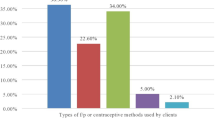Abstract
It is a common problem in India for women in the reproductive age group to suffer from reproductive illnesses and not seek care. This paper is an attempt to assess untreated reproductive morbidities and to study factors affecting treatment-seeking behavior among ever married women of urban slums. We selected 1,046 women of the reproductive age group (15–49 years) using two-stage cluster sampling for a community-based, cross-sectional study. From this sample, 593 responses reporting reproductive morbidity were analyzed for treatment-seeking behavior and its correlates. Information was collected on demographics, socioeconomic status, self-reported reproductive morbidity, and treatment-seeking patterns, along with reasons for not utilizing available health services, all using a pretested, structured interview schedule. Univariate and multivariate analyses were done in SPSS 15.0. In our sample, 57% of women had at least one reproductive morbidity; of these, only one third sought health care. Women belonging to the Scheduled Castes/Scheduled Tribes caste group (OR = 3.92, 95% CI 1.44–10.64), at a distance of more than 2 km from a health facility (OR = 2.67, 95% CI 1.28–5.58), and whose duration of illness was more than 1 year (OR = 14.44, 95% CI 3.66–56.87) accessed fewer reproductive health services compared to their counterparts. The present study found that a lower sense of need, the cost of care, and societal barriers were the reasons for not seeking care. Providers’ poor attitudes, poor quality of services, and long waiting times were found to be the reasons for not utilizing health facilities. The determinants for accessing reproductive health care were resources available at the household level, social factors, the availability of services, and behaviors related to health. Government facilities remained underutilized.
Similar content being viewed by others
Notes
National Family Health Survey of India (2004–2005)
Bohara A. Equity Effect of Rajasthan Health System Development Project on Utilization of Health services and Unmet Need for Health Care Services: A Case Study from Rajasthan, MPH dissertation, AMCHSS, SCTIMST, Kerala 2007
References
Murray CL, Lopez A. The Global Burden of Disease: A comprehensive assessment of mortality and disability from diseases, injuries and risk factors in 1990 and projected to 2020, Volume 1. Cambridge: Harvard University Press; 1996.
Xia DY, Liao SS, He QY, Choi KH, Mandel JS. Self-reported symptoms of reproductive tract infections among rural women in Hainan, China: prevalence rates and risk factors. Sex Transm Dis. 2004;31(11):643-649.
Go VF, Quan VM, Celentano DD, Moulton LH, Zenilman JM. Prevalence and risk factors for reproductive tract infections among women in rural Vietnam. Southeast Asian J Trop Med Public Health. 2006;37(1):185-189.
Rathore M, Vyas L, Bhardwaj AK. Prevalence of reproductive tract infections amongst ever married women and sociocultural factors associated with it. J Indian Med Assoc. 2007;105(2):74-78.
Prasad JH, Abraham S, Kurz KM, et al. Reproductive tract infections among young married women in Tamil Nadu, India. Int Fam Plann Perspect. 2005;31(2):73-82.
Band RA, Bang AT, Batule M, Choudhary Y, Sarmukkada S, Tole O. High prevalence of gynecological diseases in rural Indian women. Lancet. 1989;8:85-88.
Patel V, Tanksale V, Sahasrabhojanee M, Gupte S, Nevrekar P. The burden and determinants of dysmenorrhoea: a population-based survey of 2262 women in Goa, India. BJOG. 2006;113(4):453-463.
Rutstein SO, Shah IH. Infecundity, Infertility, and Childlessness in Developing Countries. Calverton: ORC Macro and WHO; 2004. DHS Comparative Report No. 9.
Rahman MM, Kabir M, Shahidullah M. Adolescent self reported reproductive morbidity and health care seeking behavior. J Ayub Med Coll Abbottabad. 2004;16(2):9-14.
Aggarwal AK, Kumar R, Gupta V, Sharma M. Community based study of reproductive tract infections among ever married women of reproductive age in a rural area of Haryana, India. J Commun Dis. 1999;31(4):223-228.
Thi Thu H, Ziersch A, Hart G. Healthcare-seeking behaviours for sexually transmitted infections among women attending the National Institute of Dermatology and Venereology in Vietnam. Sex Transm Infect. 2007;83(5):406-410.
Ray SK, Biswas R, Kumar S, Chatterjee T, Misra R, Lahiri SK. Reproductive health needs and care seeking behaviour of pavement dwellers of Calcutta. J Indian Med Assoc. 2001;99(3):142-143, 145.
Rani M, Bonu S. Rural Indian women’s care-seeking behavior and choice of provider for gynecological symptoms. Stud Fam Plann. 2003;34(3):173-185.
Guo S, Wang L, Yan R. Health service needs of women with reproductive tract infections in selected areas of China. Chin Med J (Engl). 2002;115(8):1253-1256.
Go VF, Quan VM, Chung A, Zenilman JM, Moulton LH, Celentano DD. Barriers to reproductive tract infection (RTI) care among Vietnamese women: implications for RTI control programs. Sex Transm Dis. 2002;29:201-206.
Bhatti LI, Fikree FF. Health-seeking behavior of Karachi women with reproductive tract infections. Soc Sci Med. 2002;54(1):105-117.
Bro F. Vaginal discharge in general practice–women’s perceptions, beliefs and behaviour. Scand J Prim Health Care. 1993;11(4):281-287.
Das NP, Shah U. Understanding women’s reproductive health needs in urban slums in India: A rapid assessment. Population Research Center, Baroda. 2001. Paper presented at the 24 IUSSP General Population Conference at Salvador- Bahia, Brazil. Available at: http://prcbaroda.org/Pages/Reproductive%20Health.htm. Accessed on: February 2, 2008.
WHO. Sexually transmitted and other reproductive tract infections: A guide to essential practice. Department of Reproductive Health and Research (RHR), World Health Organization. Available at: http://www.who.int/reproductive-health/publications/rtis_gep/annex1.htm#1. Accessed on: May 15, 2008.
Ensor T, Cooper S. Overcoming barriers to health services access: influencing the demand side. Health Policy Plan. 2004;19(2):69-79.
Bhavsar RD. Determinants of RTIs\STIs among women in Punjab and their health seeking behavior. Indian J Fam Welf. 2005;51(1):24-35.
Ager A, Pepper K. Patterns of health service utilization and perceptions of needs and services in rural Orissa. Health Policy Plan. 2005;20(3):176-184.
Author information
Authors and Affiliations
Corresponding author
Rights and permissions
About this article
Cite this article
Bhanderi, M.N., Kannan, S. Untreated Reproductive Morbidities among Ever Married Women of Slums of Rajkot City, Gujarat: The Role of Class, Distance, Provider Attitudes, and Perceived Quality of Care. J Urban Health 87, 254–263 (2010). https://doi.org/10.1007/s11524-009-9423-y
Published:
Issue Date:
DOI: https://doi.org/10.1007/s11524-009-9423-y




